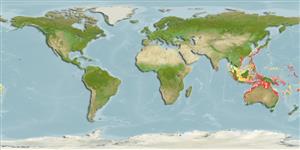Environment: milieu / climate zone / depth range / distribution range
Ekologi
laut; air tawar; payau bentopelagis. Tropical
Western Central Pacific: Australia and New Guinea.
Size / Weight / umur
Maturity: Lm ? range ? - ? cm
Max length : 30.0 cm TL jantan/; (Ref. 34016)
Occur inshore, in mangrove areas; in lotic and lentic freshwater bodies (Ref. 7300). Live in coastal marine waters, but also found in estuaries and freshwater sections of rivers (particularly in temperate southern latitudes) (Ref. 44894). Benthic omnivore, juveniles feed on algae and a range of small crustaceans, while older fish prey mainly on polychaetes (Ref. 34016). Eggs are guarded and fanned by the male parent (Ref. 205).
Eggs are guarded and fanned by the male parent (Ref. 205).
Paxton, J.R., D.F. Hoese, G.R. Allen and J.E. Hanley, 1989. Pisces. Petromyzontidae to Carangidae. Zoological Catalogue of Australia, Vol. 7. Australian Government Publishing Service, Canberra, 665 p. (Ref. 7300)
Status IUCN Red List (Ref. 130435)
ancaman kepada manusia
Harmless
penggunaan manusia
informasi lanjut
AcuanBudidaya airprofil budidaya airStrainGenetikaElectrophoresesDiturunkanPenyakit-penyakitPengolahanNutrientsMass conversion
mitraGambarStamps, Coins Misc.Suara-suaraCiguateraKecepatanTipe renangArea insangOtolithsOtakPenglihatan / visi
Alat, peralatan
laporan khas
muat turun XML
Sumber internet
Estimates based on models
Preferred temperature (Ref.
123201): 23.8 - 28.8, mean 27.6 °C (based on 416 cells).
Phylogenetic diversity index (Ref.
82804): PD
50 = 0.6250 [Uniqueness, from 0.5 = low to 2.0 = high].
Bayesian length-weight: a=0.01288 (0.00598 - 0.02775), b=3.05 (2.86 - 3.24), in cm total length, based on LWR estimates for this (Sub)family-body shape (Ref.
93245).
Trophic level (Ref.
69278): 3.2 ±0.1 se; based on diet studies.
Generation time: 2.7 ( na - na) years. Estimated as median ln(3)/K based on 1
growth studies.
Daya lenting (Ref.
120179): sedang, Waktu penggandaan populasi minimum 1.4 - 4.4 tahun (K=0.06-0.41).
Fishing Vulnerability (Ref.
59153): Low to moderate vulnerability (29 of 100).
